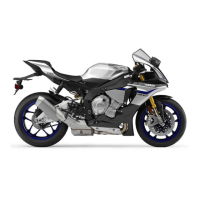
 Loading...
Loading...
Do you have a question about the Yamaha R1 and is the answer not in the manual?
| Bore x Stroke | 79.0 mm x 50.9 mm |
|---|---|
| Compression Ratio | 13.0:1 |
| Front Tire | 120/70ZR17 |
| Wheelbase | 55.3 in |
| Seat Height | 33.7 in |
| Fuel Capacity | 4.5 gal |
| Curb Weight | 448 lb |
| Width | 27.2 in |
| Height | 45.3 in |
| Fuel Delivery | Fuel Injection |
| Transmission | 6-speed |
| Front Suspension | 43mm KYB inverted fork, fully adjustable |
| Rear Suspension | KYB single shock; fully adjustable |
| Front Brakes | Dual 320mm hydraulic disc; ABS |
| Rear Brakes | 220mm disc; single-piston caliper; ABS |
| Torque | 83 lb-ft |
| Engine Type | Liquid-cooled, 4-stroke, DOHC, 4-valve, inline 4-cylinder |
Outlines the owner's responsibilities for safe motorcycle operation.
Provides guidelines for safe motorcycle operation and accident prevention.
Details essential protective clothing for rider safety.
Warns about the dangers of carbon monoxide and necessary precautions.
Gives guidelines for safely adding cargo or accessories to the motorcycle.
Discusses the risks associated with aftermarket parts and modifications.
Identifies components on the left side of the motorcycle.
Identifies components on the right side of the motorcycle.
Details the various controls and instruments on the motorcycle.
Explains the YRC system and its functions for enhanced riding.
Describes the traction control system for maintaining grip during acceleration.
Explains the lift control system for reducing front wheel lift.
Details the electronic racing suspension system for adjustable damping.
Provides a visual guide to the YRC system functions.
Explains the anti-theft immobilizer system and its components.
Describes the functions of the main switch and steering lock.
Details the functions of the left and right handlebar switches.
Lists and explains the various indicator and warning lights on the instrument panel.
Outlines the different display modes and items shown on the instrument panel.
Explains the operation and features of the clutch lever.
Describes the operation of the shift pedal.
Explains the operation and adjustment of the front brake lever.
Describes the operation of the rear brake pedal.
Details the integrated ABS and UBS brake systems.
Provides information on recommended fuel and refueling precautions.
Guides on adjusting front fork spring preload and damping.
Instructions for adjusting the rear shock absorber assembly.
Details the functions of the ignition circuit cut-off system.
Checks related to the fuel system before operation.
Checks related to the engine oil before operation.
Checks related to the coolant system before operation.
Checks related to the front brake system before operation.
Checks related to the rear brake system before operation.
Checks related to wheels and tires before operation.
Checks related to instruments, lights, signals, and switches.
Guides on how to start the motorcycle's engine correctly.
Explains the process of shifting gears for optimal control.
Details the engine break-in procedure for new motorcycles.
Provides instructions on how to park the motorcycle safely.
Describes the contents and location of the owner's tool kit.
Comprehensive maintenance and lubrication schedule.
Guide on checking and replacing spark plugs.
Procedures for checking, changing engine oil, and replacing the filter.
Instructions for checking and changing the coolant.
Importance of tire condition, replacement, and air pressure.
Steps to adjust the clutch lever free play.
Guide on checking and replenishing brake fluid levels.
Procedures for changing brake fluid and related components.
How to check and adjust drive chain slack.
Steps for cleaning and lubricating the drive chain.
How to check the condition and operation of the front fork.
How to check the steering bearings for wear or looseness.
Information about the battery, its location, and handling.
Guide on how to replace fuses.
Information about the vehicle's LED lighting system.
Instructions on how to support the motorcycle during maintenance.
Precautions for cleaning matte colored finished parts.
General advice on maintaining the motorcycle's appearance and function.
Detailed instructions and precautions for cleaning the motorcycle.
Guidelines for short-term and long-term motorcycle storage.
Provides charts for diagnosing starting and performance issues.
Troubleshooting steps for engine overheating.
Tire specifications, including size and manufacturer.
Recommended tire air pressures.
Information on vehicle and engine identification numbers.
Location and purpose of the model label.